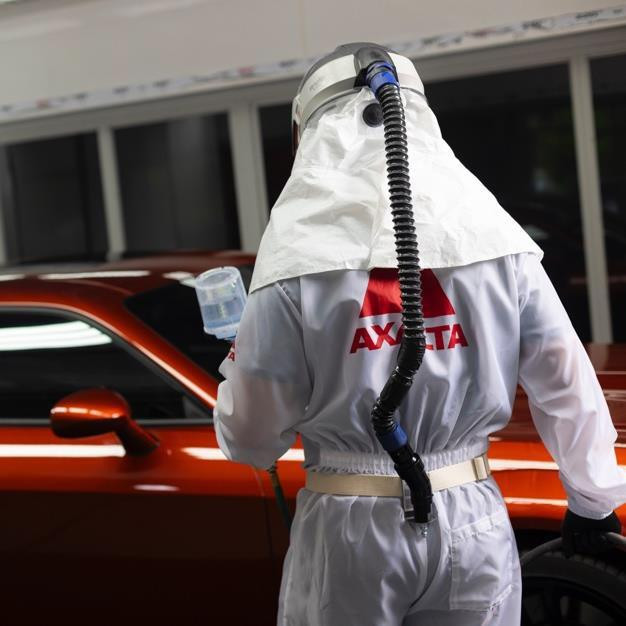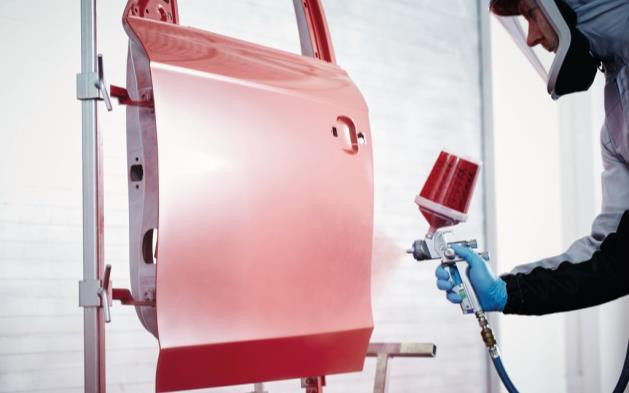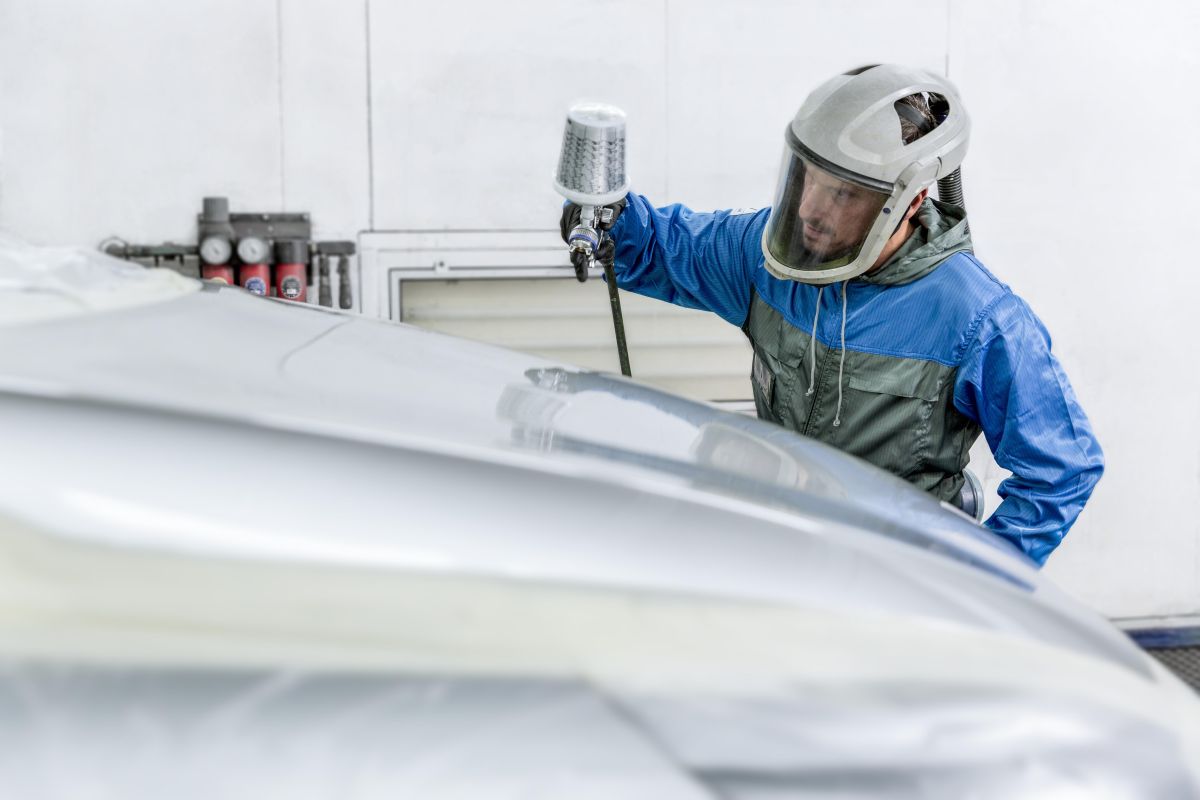As electric vehicles (EVs) become increasingly prevalent on the roadways and in collision repair facilities, shops will face new challenges and considerations to ensure they are repaired properly. Autobody News reached out to several paint manufacturers to learn about some of the issues with refinishing EVs, how they are addressing them and advice for repairers.
They included Gary Kilby, senior technical excellence training manager at Sherwin-Williams; Patrice Marcel, training director, global refinish, at Axalta; Rodolfo Ramirez, PPG vice president, automotive refinish, Americas; and Marya Salim, regional marketing director, automotive & specialty coatings – North America for AkzoNobel.
Although the four paint company representatives agreed that repairers are facing new challenges refinishing EVs, they concurred the refinish material application process remains unchanged.
The reason, according to Marcel, of Axalta, is that EVs are generally engineered and constructed in a similar way to internal combustion engine (ICE) vehicles.
“The materials used for the vehicle structure and exterior panels are either steel or aluminum blends or composite and use the same paint process at the OEM plant,” he said. “This is familiar territory for a refinisher.”
While the refinish material application process hasn’t changed, there are some unique considerations with EVs. These include color selection, due to the type of pigments and pearls used; advanced driver assistance systems (ADAS) features and other technology embedded in the vehicles; and the thermal management systems, which can impact the baking and curing process.
The Curing Process
Kilby, of Sherwin-Williams, noted one of the main challenges related to refinishing EVs is the curing process.
According to experts, each curing refinish option -- UV, infrared and baking -- has a different time window for the process to be successful and still not exceed the exposure mandated by the manufacturer. Understanding these time differences is essential.
Marcel, of Axalta, pointed out every EV manufacturer has a different recommendation for temperature and exposure time limit due to battery size, location, composition, etc.
“The range variance is quite high with temperatures varying from 55oC to 80oC and the time can extend up to two hours depending on the manufacturer and model,” he said. “This cannot be a guessing game as heat can cause permanent leaks of the battery cells and fatal damage to the high-voltage system if the recommended time of exposure is exceeded.”
He said Axalta’s goal is to minimize exposure to heat by reducing exposure time and reducing the temperature requirements to cure its products. The company has a Fast Cure-Low Energy technology specially designed for low-temperature curing and EV repairs.
“There are various types of drying equipment that exist as well, but repairers should always verify and confirm with the equipment supplier that they are safe to use with EVs,” emphasized Marcel.
Salim, of AkzoNobel, explained that the elevated temperatures commonly used when force-drying an automotive refinish system can potentially cause thermal damage to a high-voltage EV battery.
“The vehicle’s battery temperature is kept in check by using battery thermal management systems, which vary by manufacturer,” she said. “These cooling and heating systems are designed to maintain the battery temperature within the optimal functioning range to get the best performance and lifespan out of the battery cells.”
Salim said it is not unusual for electric and hybrid-electric vehicle repair procedures to require disconnecting power sources, which also disables the thermal management system. This could leave the battery unprotected from the high temperatures often used when curing paint in the booth.
 Patrice Marcel, training director, global refinish, at Axalta, stressed the importance of keeping up with the latest tools, technology and training to ensure a proper repair.
Patrice Marcel, training director, global refinish, at Axalta, stressed the importance of keeping up with the latest tools, technology and training to ensure a proper repair.
“Even when the system isn’t disabled, there is still the possibility of damage if the OEM procedures aren’t followed,” she noted. “Ultimately, the challenge is to get the paint cured efficiently without damaging the battery system.”
Ramirez, of PPG, shared some of the specific challenges around heat-sensitive high-voltage battery systems.
“While some OEMs allow traditional curing temps, others require lower thresholds,” he said.
He said ambient air-dry systems, UV-cured products and infrared solutions for localized repairs are gaining traction due to their efficiency and compatibility with EVs.
“Many OEMs now recommend low-bake procedures with clearly defined temperature thresholds, making it easier for repair facilities to deliver high-quality results on EVs,” he said. “Battery designs vary, so it's critical to follow each OEM’s specific repair and safety guidelines.”
Kilby, of Sherwin-Williams, also advised following the OEM’s recommendations regarding temperature limits and heat exposure times.
“The OEM procedure varies between different manufacturers and even within different
models of the same OEM,” he explained.
Safety Precautions
At the top of the list of precautions to take, according to Axalta’s Marcel, is ensuring workers’ safety by identifying potential hazards.
“Repairers should always refer to the manufacturer’s recommendations, which may be different from one manufacturer to the next or even to one model to the other, so it is key to consult and to adhere to those guidelines,” stressed Marcel. “Additionally, high-voltage systems and batteries are evolving, and the nature of their composition may be different, which means so is their tolerance to heat.”
Another precaution, according to Marcel, is that EVs should be assigned to an EV-trained technician and contact with the vehicle should be limited to those who are fully educated on the hazards. Lastly, he said there are often ADAS-related procedures critical for proper repair.
“Instructions on ADAS features and OEM procedures specific to the vehicle should be provided to the specialized EV-trained technician before starting a refinish job,” Marcel added.
He cautioned repairers to pay close attention to the vehicle’s high-voltage system.
“High voltage systems may require a special disconnect procedure and trained technicians to move them due to the charging system being connected to wheel movement,” he said.
Ramirez, of PPG, said safety should always start with education and adherence to OEM guidelines.
“Technicians should be trained to identify high-voltage components and understand proper isolation, lockout / tagout techniques and the use of proper personal protective equipment (PPE) in addition to standard safety operating procedures,” Ramirez said. “The use of low-temperature or non-thermal curing methods can further reduce risk during refinish operations.”
Salim, of AkzoNobel, recommended repairers to read and completely understand the OEM procedures developed for the vehicle being repaired.
“It is critical for the repairer to be fully informed of the necessary processes and precautions; not only to protect the vehicle battery, but also to minimize the chance of a life-threatening explosion, fire or electrocution,” she said.
“Besides the safety precautions that need to be taken, using products that allow a reduced cure time and temperature for baking is a safe way to go without compromising quality,” advised Marcel, of Axalta. “Additionally, stay up to date with the changing OEM specifications by researching the procedures for each vehicle and make sure the technicians have that paperwork.”
PPG’s Ramirez said the most important step remains to follow the OEM’s repair and safety procedures specific to the vehicle model being serviced.
“For EV repairs, consider curing methods that avoid elevated temperatures,” he offered. “Air-dry and UV-cure solutions offer great options.”
He said standard refinishing methods may be used if the battery has been removed during the repair process, provided all safety and process guidelines are followed. Additionally, many newer EVs come in a broader, more vibrant range of colors than traditional vehicles, so using a premium paint product can be important.
“These premium product lines have the largest color databases and advanced digital tools for highly accurate color selections,” he added.
Company Insights
In light of the different EV considerations, Salim, of AkzoNobel, stressed the importance of including the refinish department in the repair plan.
“Understanding the parameters set by the automaker allows the repair planner and painter to determine what steps need to be taken so the maximum temperature and exposure times aren’t exceeded,” she pointed out.

Salim said creating a refinishing plan to ensure the vehicle’s battery system is not damaged can be a simple process, but must begin by referencing the OEM repair procedures and following them throughout all phases of the repair.
“It is critical for the repairer to be fully informed of the necessary processes and precautions,” she emphasized. “Adjusting refinish procedures to accommodate the automakers’ restrictions doesn’t have to be complicated or confusing. Just make sure the OEM repair procedures -- even for curing paint -- are followed and that you make your paint system selections accordingly.”
In standard basecoat/clearcoat refinish systems, Salim said clearcoat curing specifications found in the product technical data sheet will determine whether the refinish operation will meet the parameters set by the vehicle manufacturer to prevent damage to the battery system. She said AkzoNobel offers several paint systems that can be effective in reducing bake time, temperature or both.
“For example, some clearcoat systems are designed specifically for low bake temperatures or even ambient air-dry conditions,” Salim explained. “Others offer various bake times and temperatures depending on which hardener or accelerator is selected.”
Ramirez said PPG offers a wide range of advanced solutions for EV repairs, including air-dry, UV-cure, low-bake and infrared solutions.
“These options are all designed to minimize heat exposure and align with OEM guidelines while maintaining and improving shop productivity,” he noted.
Kilby said Sherwin-Williams has focused on improving cycle times and reducing energy costs for many years.
“The focus on reducing both has positioned us well with the curing process for EVs,” he said. “Our continued collaborative relationship with automakers will allow us to meet future OEM requirements.”
In addition, Sherwin-Williams has supported options for alternative curing methods like UV and infrared (IR) to allow for a “target cure.”
Advice for Repairers
Ramirez, of PPG, said body shops are turning to premium paint systems, digital tools and process automation for improved efficiency in collision repairs for both EV and ICE vehicle repairs.
“The combination of premium paint systems, precise digital matching and automated mixing gives technicians confidence when dealing with EV-specific color variants and complex finishes,” he explained.
Depending on the severity of the damage and the extent of structural repair required, Axalta’s Marcel said tools and equipment, such as wheel dollies or tire skates, may be needed to safely repair EVs.
“Keeping up with the latest tools, technology and training is critical to a proper repair,” he said. “Having the proper training and the ability to access manufacturers’ technical information is mandatory.”
He noted a trained technician will recognize the high-voltage components and labels during the refinish process and will take the proper safety measures when cleaning, sanding and masking.
Salim, of AkzoNobel, recommended considering all options available as some are easily overlooked. For example, depending on the specifics of the repair and the equipment available, infrared curing may be an excellent solution for battery temperature restrictions. When using infrared, the heat energy is localized and, in most situations, will not directly impact the battery system.
“Keep in mind that it is critical to be aware of the locations of high-voltage batteries to avoid accidentally overheating when curing with infrared,” she advised. “Another option to consider is when the vehicle will be painted. Scheduling the EV as the last job of the day may allow for an extended dry time at a reduced booth temperature or an overnight drying period at moderate ambient temperatures.”
Sherwin-Williams’ Kilby suggested scheduling booth audits to verify the time to achieve the set baking temperature.
Additionally, he said a secondary timer or reminder can be set to verify that the bake cycle
has been completed.
“A faulty shutoff timer could result in an EV being exposed to high heat for longer than intended,” he explained.
Overall, all agreed that being familiar with the automakers’ recommendations is key.
“In the EV refinish process, it cannot be stressed enough how critical it is to follow the OEM’s recommendations for repairing and refinishing EVs,” said Kilby. “Never assume the procedures are similar from one OEM to another or from one model to another.”














Stacey Phillips Ronak